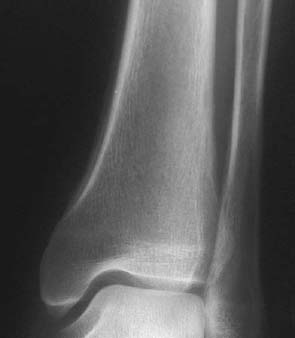CASE 124 Peter L. Munk and Anthony G. Ryan A 58-year-old man presented with pain in his leg, with erythema and swelling visible overlying his shin distally. Figure 124A A coned view of the distal tibia (Fig. 124A) shows a subtle sclerotic line paralleling the medial aspect of the tibial cortex. Secondary hypertrophic pulmonary osteoarthropathy (HPOA) (Marie-Bamberger disease). Differential of a periosteal reaction, including underlying osteomyelitis or neoplasm. This condition is composed of a triad consisting of clubbing of the digits and painful joints (secondary to synovitis) with accompanying periosteal new bone formation. HPOA is most frequently associated with underlying intrathoracic causes. Other conditions producing chronic inflammation have also been reported to precipitate this condition. The vast majority of patients have bronchogenic carcinoma (particularly adenocarcinoma and squamous carcinoma), although other conditions, such as mesothelioma, pulmonary abscess, and bronchiectasis, as well as metastatic disease, have been reported as causes. It is estimated that at least 5% of patients with bronchogenic carcinoma will develop HPOA. Nonthoracic causes have also been described, including chronic liver disease (e.g., biliary cirrhosis and Wilson’s disease), Crohn’s disease, gastrointestinal tract malignancies, and chronic infection of vascular grafts. More recently, HPOA has been described as a noninfectious musculoskeletal association of acquired immunodeficiency syndrome. In the pediatric age group, a common underlying condition is cystic fibrosis. Although the underlying cause is unclear, the condition appears to be neurogenically mediated, as a paraneoplastic syndrome, producing the release of vasodilators and leading to increased blood flow, particularly noted in the distribution of the vagus nerve. Other theories suggest a hormonal origin, with estrogen, prostaglandin, and various growth factors implicated; 10% of bronchogenic carcinomas have a hormonal output. The majority of patients are middle-aged men, frequently presenting initially with clubbing of the digits, which, in the case of bronchogenic carcinoma, may be of relatively rapid onset and quite painful. This is secondary to soft-tissue hypertrophy and is not associated typically with changes in the underlying phalangeal tufts. Associated symptoms in the joints may be present at this time or develop later. Synovitis is said to develop in as many as 40% of patients with bronchogenic carcinoma. Patients usually present with one or several burning, painful, tender joints. Most commonly affected are the ankles (88%), wrists (83%), and knees (75%). Synovial effusions are common.
Hypertrophic Pulmonary Osteoarthropathy
Clinical Presentation

Radiologic Findings
Diagnosis
Differential Diagnosis
Discussion
Background
Etiology
Pathophysiology
Clinical Findings
Stay updated, free articles. Join our Telegram channel

Full access? Get Clinical Tree


